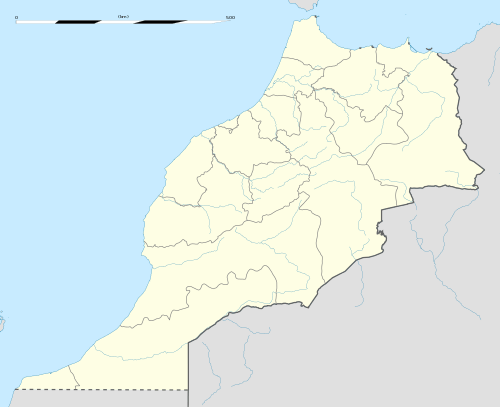Sidi Ifni
| Sidi Ifni | |
|---|---|
| City | |
|
Sidi Ifni (partial view) | |
 Sidi Ifni Location in Morocco | |
| Coordinates: 29°23′N 10°10′W / 29.383°N 10.167°W | |
| Country |
|
| Region | Guelmim-Oued Noun |
| Province | Sidi Ifni Province |
| City | Sidi Ifni |
| Population (2004) | |
| • Total | 20,051 |
| Time zone | WET (UTC+0) |
| • Summer (DST) | WEST (UTC+1) |
Sidi Ifni (Arabic: سيدي إفني) is a city located in southwest Morocco, on the shores of the Atlantic Ocean. It has a population of 20,000 people. The economic base of the city is fishing. It is located in Guelmim-Oued Noun region and Sidi Ifni Province. Its inhabitants are the Shilha from the Ait Baamrane tribe. In 2000, an important fishing port was concluded, which serves as a base for fish exports.
History
The Ait Baamran tribe has long inhabited the small town and the region surrounding it. They worked in husbandry and traded with Europeans and northern Morocco being intermediaries in the trans-Saharan trade.[1]
In 1476, an enclave in the region of present-day Sidi Ifni was occupied by Spain, which named its settlement there Santa Cruz de la Mar Pequeña. It remained in Spanish hands until 1524 when it was captured by Saadian rulers.
Historically, Sidi Ifni is claimed to be the location of Santa Cruz de la Mar Pequeña, which had been for long pursued by Spain who built a small coastal fortress there in the 15th century. Although the existence of the fortress is widely documented, historians could not determine its exact location along the coast between Agadir and Tarfaya. In 1860, following the Spanish-Moroccan War, Morocco conceded Sidi Ifni and the territory of Ifni to Spain as a part of the Treaty of Tangiers. During the period often termed the "Scramble for Africa" in 1884, Spain acquired what is now Western Sahara. Spain occupied Sidi Ifni and Western Sahara jointly, although the latter was formally known under the name Spanish Sahara, or Río de Oro and Saguia el-Hamra.
Until 1952, Ifni region had the status of a protectorate. In this year, the region became part of Spanish West Africa (entity that grouped the colonies of Spanish Sahara and Cape Juby, with its capital defined in Villa Bens—Tarfaya nowadays—in Morocco).
Since Morocco obtained its independence in 1956, it claimed the territory in various occasions. The first was in August 1957, by stating that the French-Spanish treaty from 1912 had been derogated. By late 1957 serious incidents had occurred in the border, starting the Ifni War, being Ifni garrisons attacked by the irregular troops led by Moroccan nationalists of the Istiqlal party, and supported tacitly by the king. They called themselves Moroccan Liberation Army.
The Spanish Army retreated from most territory with the purpose of establishing a defensive line limited to Sidi Ifni surroundings. The Moroccan Liberation Army just took control of the abandoned territory. However, this war was never formally declared nor finished. Spain and Morocco signed on 1 April 1958 the Agreements of Angra de Cintra, by which Cape Juby was given to Morocco in June 1958. The lost territories of Ifni region were never regained. They were integrated in Morocco. In the defensive line in Sidi Ifni the border was settled and the city remained under Spanish rule as one actual province of Spain.
In 1969, mostly due to international pressure, Spain relinquished Sidi Ifni to Morocco.
Ifni protests
In June 2008, violent protests took place in Sidi Ifni; according to the first media reports eight people were killed by police forces, but this claim was later not substantiated.
On May 30, dozens of unemployed workers started to block the port as to protest against not having been employed there. Unloading of fish was hindered. The following day, barriers were erected around the port. Several mediation intents with local officials gave no result. On June 6, around 500–600 people protested in the town and, moved by rumours that a police force from Tiznit or Agadir was to arrive, in the first hours of June 7, several entrances to the town were blocked by protesters. A local official was severely harassed by the protesters. At 6:30 a.m. on the same day, a police force composed of some 8,000 agents entered the city, dispersed the protesters employing rubber bullets and reopened the port[2] Many of the protesters fled to the surrounding mountains. The police then entered houses in the neighbourhoods of Boulaalame and Lalla Meryem and started to arrest people in a violent way. Abuse, harassment and theft took place. Around 182 people were detained and all but 10 were liberated later that day. Twelve cases of torture leading to up to 30 days of temporal incapacity and around 35 cases of aggression or harassment were proven by the Moroccan Human Rights organisation OMDH.[3]
On June 7, the Qatar-owned TV chain Al Jazeera stated that between eight and 10 people had been killed during the police intervention. Amnesty International's 2009 report reads that, "They [the Moroccan police] also conducted unauthorized raids on homes, confiscated property, verbally and sexually harassed people, and carried out arbitrary arrests and detentions."[4] The relation between the Moroccan government and Al Jazeera was seriously deteriorated[2] and in July, Brahim Sbaalil, a spokesperson for the Islamist-leaning Centre Marocain des Droits Humain (CMDH) that had echoed the claim, was condemned to six months in prison for "spreading false accusations".[5]
Climate
Influenced by the cold Canary Current, Sidi Ifni has a mild desert climate (Köppen BWn) with mild to warm weather all year round, and very slight, erratic rainfall. This rain falls only during the winter months from November to April, and generally is significant only when the North Atlantic Oscillation is negative and drives the winter frontal storms that are normally well north of central Morocco into the region.
| Climate data for Sidi Ifni | |||||||||||||
|---|---|---|---|---|---|---|---|---|---|---|---|---|---|
| Month | Jan | Feb | Mar | Apr | May | Jun | Jul | Aug | Sep | Oct | Nov | Dec | Year |
| Average high °C (°F) | 19 (66) |
19 (67) |
21 (69) |
22 (71) |
22 (71) |
22 (72) |
24 (75) |
24 (75) |
24 (75) |
24 (75) |
23 (74) |
21 (69) |
22 (72) |
| Average low °C (°F) | 11 (52) |
12 (54) |
14 (57) |
15 (59) |
16 (60) |
17 (62) |
18 (64) |
18 (64) |
18 (64) |
17 (62) |
16 (60) |
13 (56) |
16 (60) |
| Average rainfall cm (inches) | 3 (1) |
2.3 (0.9) |
1.3 (0.5) |
1.5 (0.6) |
0.3 (0.1) |
0.5 (0.2) |
0 (0) |
0 (0) |
0.8 (0.3) |
0.8 (0.3) |
2 (0.8) |
4.1 (1.6) |
16.6 (6.3) |
| Source: Weatherbase[6] | |||||||||||||
Gallery

 The governor's palace
The governor's palace.jpg) Legzira beach
Legzira beach_-_02.jpg) Legzira beach
Legzira beach The mosque
The mosque.jpg) Sidi Ifni beach
Sidi Ifni beach- Argan
- The fruits of Opuntia ficus-indica
 The fruits of Opuntia ficus-indica
The fruits of Opuntia ficus-indica Beach in the sunset
Beach in the sunset
References
- ↑ Attilio, Gaudio (1990). Guerres et paix au Maroc: reportages, 1950-1990. KARTHALA Editions. p. 175.
- 1 2 Les dessous de l’affaire Al Jazeera
- ↑ Rapport de la commission d'enquête de l'OMDH sur les événements de Sidi Ifni
- ↑ "Morocco/Western Sahara | Amnesty International Report 2009". Amnesty International. Retrieved 2012-11-18.
- ↑ "Sidi Ifni: Brahim Sbaalil écope de six mois de prison ferme - Archive". Yabiladi.com. Retrieved 2012-11-18.
- ↑ "Weatherbase: Historical Weather for Sidi Ifni, Morocco". Weatherbase. 2011. Retrieved on November 24, 2011.
External links
| Wikivoyage has a travel guide for Sidi Ifni. |
| Wikimedia Commons has media related to Sidi Ifni. |
- (Spanish) Ifni Friend's Association (Asociación de Amigos de Ifni)
- (Spanish) The Corner of Sidi Ifni (El Rincón de Sidi Ifni)
- Lexicorient
Coordinates: 29°23′N 10°10′W / 29.383°N 10.167°W
.jpg)